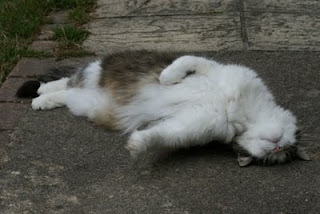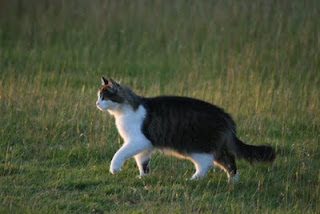 Dear George
Dear GeorgeI am one of two black brothers in the care of West Oxfordshire Cats Protection (www.westoxoncats.co.uk ). As you can see we look very much alike - apart from four interesting features. My paws are bigger and (I think) better because they have six digits not just five. You can see the difference in the photo of me (higher up) and my brother and see how it looks from the detailed photo of my back paw. Some cats have seven digits.
Love CP Kitten
Dear CP Kitten,
Impressive. I see that your feet look sort of large when you are sitting down and there's an odd sort of bump sticking out. I can only count five on the bottom photo of your paw close up, but, of course, the sixth digit is higher up the leg. I can just see the dew claw
 on the bottom middle of that picture. I like the way the paw pad has got a little extra bit on the left hand side (in the bottom photo). Normal cat feet have four digits at the bottom and the smaller one up the side of the ankle (so to speak).
on the bottom middle of that picture. I like the way the paw pad has got a little extra bit on the left hand side (in the bottom photo). Normal cat feet have four digits at the bottom and the smaller one up the side of the ankle (so to speak).A scientist who studied more than 100 polydactyl cats reported that extra digits were more common on the front than the back paws, though you have them on both. Also sometimes there were seven digits in all - ie six on the main pawpad. Sometimes the extra toe is just an extra dew claw higher up rather than a full toe. Just occasionally the claws on the extra toes retract differently on the back paws from the normal claws.
Extra toes are the result of a domi
 nant gene (according to C. H. Danforth author of Morphology of the feet in polydactl cats,American Journal of Anatomy, (1947) 80, 143-171 available on Google Scholar). Exactly how many extra toes and their size and shape varies from one individual to another. Six or seven toed cats aren't going to have any great advantage, so that evolution isn't going to encourage them to flouish at the expense of ordinary cats.
nant gene (according to C. H. Danforth author of Morphology of the feet in polydactl cats,American Journal of Anatomy, (1947) 80, 143-171 available on Google Scholar). Exactly how many extra toes and their size and shape varies from one individual to another. Six or seven toed cats aren't going to have any great advantage, so that evolution isn't going to encourage them to flouish at the expense of ordinary cats.I guess we cats just have to be grateful that cat breeders aren't interested in this variation. There are always humans interested in the bizarre who are breeding bald animals, animals with stumpy legs, animals with floppy ears, huge animals or tiny animals. I have even seen photos of bald guinea pigs.
Humans can't mind their own business. They start with some unusual animals, breed them to each other, keep breeding them with each other and, bingo, there's a new breed with a tiny gene pool (unhealthy). Luckily six toed cats have escaped the attention of these humans and so, because they are not inbred, are as healthy as normals. Let's hope it stays that way.
Love George












